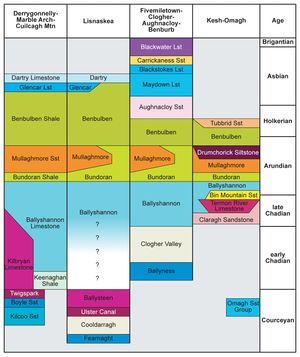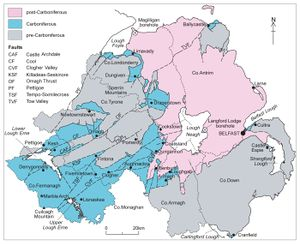Carboniferous of East County Tyrone, Northern Ireland
| Mitchell, W I (ed.). 2004. The geology of Northern Ireland-our natural foundation. Geological Survey of Northern Ireland, Belfast. |
W I Mitchell
Introduction









The succession in east Co. Tyrone (P947927) rests unconformably on the Tyrone Igneous Complex [1] and on Devonian rocks of the Fintona Block and is concealed in the east by Mesozoic and Cenozoic rocks [2]. Coal mines operated at Coalisland from at least 1672 until the early 1960s. Lithostratigraphical details were largely obtained from boreholes drilled in search of coal [3] and from quarries in Viséan limestone and Westphalian mudstone used in the manufacture of cement and bricks, respectively.
Tyrone Group (P947933)
The lowest units of the Tyrone Group east of Pomeroy are the Chadian Ballyness and Clogher Valley formations. Succeeding limestones are correlated [3] with the Ballyshannon Limestone Formation. The Carland Sandstone Formation, exposed in Carland quarry [H 792 668] 4 km NNW of Dungannon [2], contains the miospore Perotrilites tesselatus, and is Holkerian to early Asbian.
Armagh Group
The late Viséan Armagh Group is exposed in Ballysudden quarry [H 801 748], 3 km SSW of Cookstown (P947815). The Derryloran Grit Formation consists of non-marine sandstone with channel bedforms up to 5m deep and fossiliferous marine sandstone. The Rockdale Limestone Formation consists mainly of packstone and oolitic, oncoidal and pisolitic grainstone, sandstone and thin mudstone (P947820). Purplish to reddish brown palaeosols occur above palaeokarst surfaces that, at one horizon, include a 15 m deep doline (P947999). Abundant fossils including foraminifera, brachiopods and corals identify the early-late Asbian and Asbian-Brigantian boundaries (P947820).
Leitrim Group
The Rossmore Mudstone Formation in Derraghadoan quarry [H 793 644] consists of dark grey mudstone, thin siltstone and fine-grained sandstone [3] (P948000). The lower part contains the ammonoid Sudeticeras crenistriatus, indicating the Brigantian P2a Biozone, but the upper part is undated and may be Pendleian.
Millstone Grit
Exposures of the Millstone Grit consist mainly of coarse-grained sandstone but the lithological variability of the succession (P947899) was defined in boreholes [3]. Palynological data confirm the presence of a mid-Carboniferous hiatus [4] (P947927).
Coal Measures
The only exposure of Westphalian Coal Measures in Northern Ireland is in the brick pit [H 834 662] at Coalisland. Boreholes [3] show the rocks consist of 275 m of grey mudstone, silty mudstone, fine-grained sandstone, fireclay and coal seams (P947899). The Coalisland Marine Band contains the ammonoid Gastrioceras subcrenatum that marks the base of the Westphalian Series.
References
- ↑ Geological Survey of Northern Ireland 1983. Cookstown, Northern Ireland Sheet 27. Solid Geology. 1:50 000. (Southampton: Ordnance Survey for the Geological Survey of Northern Ireland).
- ↑ 2.0 2.1 Geological Survey of Northern Ireland 1960. Dungannon, Northern Ireland Sheet 35. Solid Geology. 1:63 360 (Southampton: Ordnance Survey for the Geological Survey of Northern Ireland).
- ↑ 3.0 3.1 3.2 3.3 3.4 Fowler, A, and Robbie, J A. 1961. Geology of the country around Dungannon. Memoir of the Geological Survey of Northern Ireland, Sheet 35 (Northern Ireland).
- ↑ Ramsbottom, W H C, Calver, M A, Eagar, R M, Hodson, F, Holliday, D W, Stubblefield, C J, and Wilson, R B. 1978. A correlation of Silesian rocks in the British Isles. Geological Society, London, Special Report, 10.